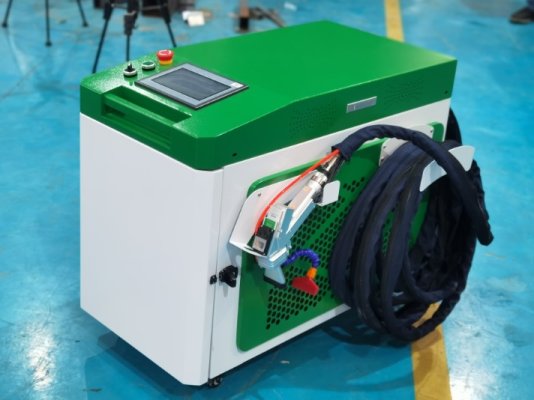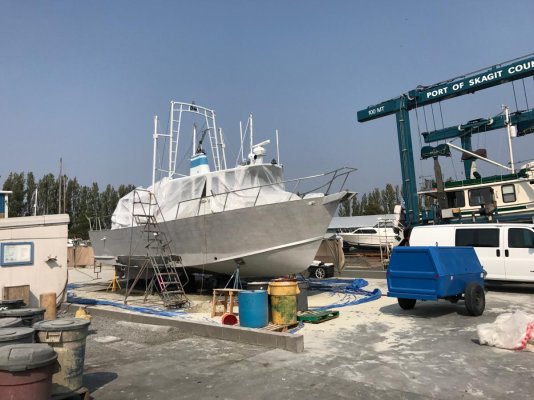LeoKa
Guru
- Joined
- Apr 15, 2017
- Messages
- 1,150
- Location
- USA
- Vessel Name
- Ironsides
- Vessel Make
- 54' Bruce Roberts steel sailboat hull, coastal LRC, 220HP CAT 3306.
I have been searching for a renting laser rust/paint remover equipment. I was not lucky so far. At least not in the PNW area. My steel hull needs a serious cleaning, but yards do not want to allow blasting anymore for DIY boar owners.
The laser tool would be perfect, since it is very environmental friendly and based on the videos I have seen, it could handle surfaces, which are impossible to clean with sanders. My boat’s hull has plenty of those.
I understand that a laser tool is quite slow, - if you have a smaller unit, - but if I have something plenty as a retired person, is time. Of course, large industries can afford very powerful laser equipment ( navy, Air Force, commercial shipping, etc. ), which can handle large surfaces. Their budget is bit bigger then mine.
Few years ago, I had a conversation with a private business, which would consider renting me an equipment like this for a week for about 3K. He would not be interested in renting for 2-3 days only, which I think the hull cleaning would take in my case. So, I postponed the deal.
Recently I started to look around on the subject again. Prices come down significantly, although a basic level equipment is still hovering in the 10-15K price range to buy from a US company.
But.
If I go to the well known Asian online source, some of the basic level laser cleaning equipment can be as low as 1-3K. That price is something I would consider as a good investment. If I store it somewhere and use it every 2-3 years once, it will recover its price very quickly. Yes, with a smaller equipment I will need more than 2-3 days, but sanding would take even longer. Again, the hull/rudder/beam has countless corners and angles, which is very difficult to clean down to base metal.
Hiring a company today for blasting a steel hull is still over 10K in our area and the results are not guaranteed. This was the case with my boat. The previous owner paid over 21K for a full hull blasting and painting job at a reputable yard here. The first thing the diver told me when he cleaned the hull just few years after, was that the hull has blisters all over. I still have the video he gave me as the new owner of the boat.
What I don’t know, if those prices are for refurbished and used equipment, or it is false advertising? Or, the prices came down that much? The web site I am referring to has the word express in it. You can look it up yourself.
I am looking for opinions on the buy, or not to buy, of a laser ablation equipment? Has anyone ever used one? If yes, how productive the cleaning process was? Pro, or contra, of this surface cleaning for metal boats? Or just your idea of buying versus renting it? Thanks.
The laser tool would be perfect, since it is very environmental friendly and based on the videos I have seen, it could handle surfaces, which are impossible to clean with sanders. My boat’s hull has plenty of those.
I understand that a laser tool is quite slow, - if you have a smaller unit, - but if I have something plenty as a retired person, is time. Of course, large industries can afford very powerful laser equipment ( navy, Air Force, commercial shipping, etc. ), which can handle large surfaces. Their budget is bit bigger then mine.
Few years ago, I had a conversation with a private business, which would consider renting me an equipment like this for a week for about 3K. He would not be interested in renting for 2-3 days only, which I think the hull cleaning would take in my case. So, I postponed the deal.
Recently I started to look around on the subject again. Prices come down significantly, although a basic level equipment is still hovering in the 10-15K price range to buy from a US company.
But.
If I go to the well known Asian online source, some of the basic level laser cleaning equipment can be as low as 1-3K. That price is something I would consider as a good investment. If I store it somewhere and use it every 2-3 years once, it will recover its price very quickly. Yes, with a smaller equipment I will need more than 2-3 days, but sanding would take even longer. Again, the hull/rudder/beam has countless corners and angles, which is very difficult to clean down to base metal.
Hiring a company today for blasting a steel hull is still over 10K in our area and the results are not guaranteed. This was the case with my boat. The previous owner paid over 21K for a full hull blasting and painting job at a reputable yard here. The first thing the diver told me when he cleaned the hull just few years after, was that the hull has blisters all over. I still have the video he gave me as the new owner of the boat.
What I don’t know, if those prices are for refurbished and used equipment, or it is false advertising? Or, the prices came down that much? The web site I am referring to has the word express in it. You can look it up yourself.
I am looking for opinions on the buy, or not to buy, of a laser ablation equipment? Has anyone ever used one? If yes, how productive the cleaning process was? Pro, or contra, of this surface cleaning for metal boats? Or just your idea of buying versus renting it? Thanks.




